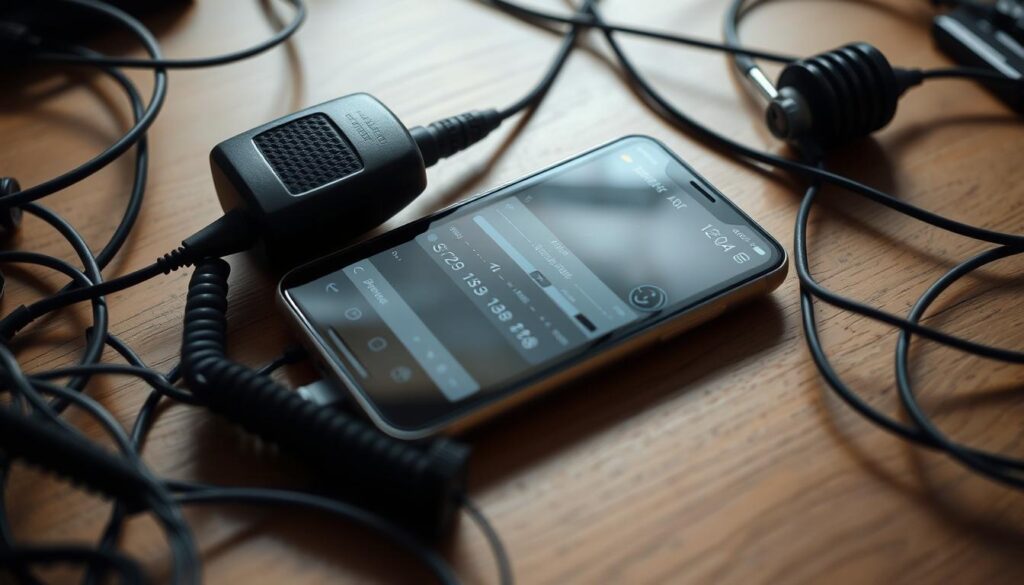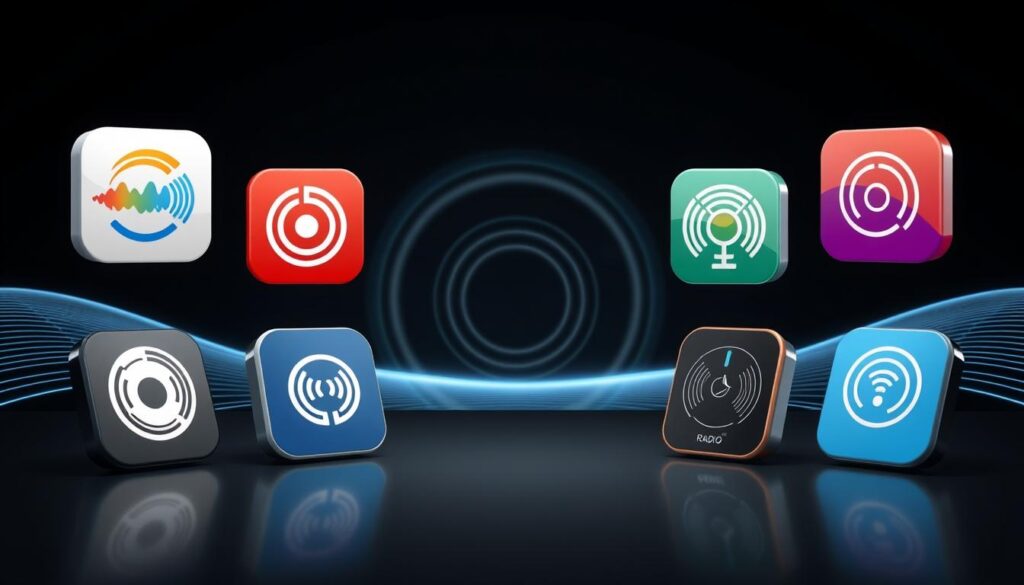Convierte tu celular en una radio aficionada con esta app
Advertisements
Imagine being at home in Mexico City, enjoying a tequila, while chatting with someone in São Paulo. Today's technology makes it possible without expensive equipment.
The digital revolution has transformed mobile devices into professional tools. You can now access communication networks from anywhere, simply by downloading specialized software.
Advertisements
What advantages does this innovation offer? Borderless connectivity, significant savings, and maximum portability. In the US and Latin America, more and more enthusiasts are adopting these solutions.
In this article, you'll discover the five best options available, including EcoLink, which enables experiences like the one mentioned above. Get ready to explore a world of possibilities at your fingertips.
Advertisements
What is an amateur radio app for cell phones?
Technology has evolved to bring the experience of wireless communication to your mobile device. These digital tools transform your phone into a versatile device, without the need for specialized hardware.

Definition and how it works
These programs emulate the operation of traditional equipment using IP connections. They use global servers and repeaters to transmit signals in real time. The magic happens like this:
- Your device connects to the internet (WiFi or mobile data)
- The application accesses distributed repeater networks
- Signals are digitally modulated for different protocols
Solutions like EcoLink integrate existing networks with digital platforms, enabling professional-quality international communications.
Benefits of using your smartphone as an amateur radio
Replacing bulky equipment with your mobile device offers clear advantages:
- Absolute portability: Carry your streaming station in your pocket
- Reduced cost: Eliminate investments in expensive hardware
- Instant updates: New features coming via updates
In emergency situations, tools like Pocket Packet Radio prove their value. They transmit critical data when other networks fail.
The best? Support for multiple operating modes, from PSK31 to packet radio. All without additional cables.
The 5 best apps to turn your phone into a radio station
Explore a universe of global connections directly from your mobile device. These solutions combine advanced technology with intuitive interfaces for beginners and experts alike.

EcoLink: Bridge between continents
Connect with more than 70 countries through its interactive map of repeaters. Ideal for travelers who need to maintain constant contact.
- Real-time display of active nodes
- Filters by type of modulation and frequency
- Automatic connection history
DroidPSK: Encrypted Messages on the Go
Decodes BPSK31/63 signals with professional precision. A highlight: operators in Rio de Janeiro coordinating local events from bars.
- Support for external Bluetooth keyboards
- Offline mode for areas without coverage
- Optimized battery consumption
RepeaterBook: The Radio Amateur's GPS
Access to 20,000+ repeaters updated in your local database. Works even without an internet connection while traveling.
HamSphere: Virtual Realism
Simulates 20 virtual antennas with 50W of power. Includes advanced tools:
- Waterfall spectrum for spectral visualization
- Integration with ISS Detector for satellite tracking
- Integrated oscilloscope for diagnostics
Pocket Packet Radio: Emergency Communication
Send APRS data with automatic contact logging. Key Statistics:
- Average latency: 120ms on 4G networks
- Battery life: 8 hours of continuous use
- Stability of the 98.7% in testing
How to choose the best app for your needs
Choosing the perfect tool depends on several key factors that you should evaluate. Not all options work the same in every situation.
License and legal requirements
In the US, the FCC regulates this service under Part 97. Some programs require a license while others operate on open frequencies.
Unlicensed options: HamSphere offers realistic, permission-free simulations. Ideal for beginners.
Important: Broadcasting on restricted bands can result in fines of up to $10,000.
Coverage by region
EcoLink dominates in North America with 1,200+ repeaters. HamSphere performs better in Europe.
- Frequent travelers: RepeaterBook updates its offline database
- Rural areas: DroidPSK works with minimal signal
- Cities: EcoLink reduces interference
Communication format
Each need requires different tools:
| Purpose | Best option |
|---|---|
| Clear voice | EcoLink |
| Encrypted messages | DroidPSK |
| APRS data | Pocket Packet Radio |
Google Play reviews highlight that EcoLink maintains the 94%'s stability during calls. RepeaterBook has a 4.7-star rating for its travel utility.
Remember to check for updates on the web official of each developer. Regulations change frequently.
Basic configuration of amateur radio apps
Preparing your device for professional communications is easier than you think. With the right settings, you'll transform your smartphone into a powerful streaming tool.
Permissions required on your device
These tools require access to certain features on your computer. Here's the lowdown:
- Precise location: To find nearby repeaters
- Microphone: Allows voice transmission with clarity
- Storage: Save contact records and settings
On Android, enable permissions in Settings > Apps. On iOS, go to Settings > Privacy. Pro tip: Check permissions after each update.
Tips for a stable connection
Avoid cuts and improve quality with these settings:
- Configure QoS on your router to prioritize UDP traffic
- Use 5GHz networks to reduce interference
- Disable battery saving during long sessions
If you experience high latency, try these steps:
- Restart the application
- Switch to a less congested network
- Check the signal strength
For longer sessions, consider:
- Airplane mode with WiFi on
- Quality external batteries
- Thermal dissipation cases
Connecting accessories improves performance. External antennas and USB audio interfaces elevate the experience. On the iPhone 15 Pro Max, EcoLink offers seamless compatibility with Lightning accessories.
Advantages of using apps over traditional equipment
Forget about heavy equipment: your smart device is now your best ally. Technological evolution enables professional experiences without excessive investments or complicated logistics.
Portability and economic savings
Conventional equipment is prohibitively expensive for many enthusiasts. A basic transceiver like the IC-7300 costs over 1000 Mbps, while digital solutions are affordable.
Cost comparison:
| Component | Traditional equipment | Mobile Settings |
|---|---|---|
| Transceiver | $1,200+ | $0-$20 |
| Antennas | $150-$500 | $0-$50 |
| Accessories | $300+ | Optional |
Portability is another key advantage. A real-life case demonstrated successful QRP communication from Pico de Orizaba using only a mobile phone with DroidPSK.
Exclusive smart features
These modern tools include features that are impossible on physical equipment:
- Automatic geolocation: Perfect for SOTA (Summits On The Air) activities
- Integration with wearables such as smartwatches
- Real-time translation for international contacts
Platforms like DroidPSK offer SSTV/FT8 decoding directly on your device. The best? Constant updates add new modes at no additional cost.
In emergencies, the combination of GPS and integrated databases saves lives. It automatically locates nearby repeaters when you need them most.
Legal and ethical precautions when using these apps
Operating on amateur frequencies carries legal responsibilities that you can't ignore. The FCC establishes clear rules to protect all users of the electromagnetic spectrum.
Authorized spectrum areas
In the United States, the Federal Communications Commission assigns specific bands for amateur use. These are the main permitted frequencies:
- 144-148 MHz: VHF band ideal for local communications
- 420-450 MHz: UHF with better penetration in urban areas
- 28.3-28.5 MHz: HF for long-distance contacts
Always avoid frequencies reserved for:
- Military communications
- Citizens' bands (CB)
- Emergency services
"Interferir con frecuencias protegidas puede acarrear multas hasta de $25,000 USD por infracción"
Fundamental ethical principles
ARRL recommends these responsible practices:
- Identify yourself clearly with your assigned call sign
- Never interrupt emergency communications
- Double check the frequency before transmitting
In 2022, three HamSphere users received sanctions for:
- Stream music on restricted bands
- Impersonating official call signs
- Intentionally blocking repeaters
How to prevent problems? Use apps like RF Analyzer to scan frequencies before operating. Keep your license up to date if required.
Remember: The radio spectrum is a shared resourceYour behavior affects thousands of operators. By following these guidelines, you'll enjoy this technology safely.
Alternatives for listening to amateur radio without an app
Did you know there are options for tuning into broadcasts without installing any software? Today's technology allows you to access global communications directly from your browser.
Browser-based solutions
WebSDR leads this market with 15 strategic servers. They cover the Netherlands and Japan, with the following features:
- Minimum requirements: Browser with WebGL and 1.5 Mbps bandwidth
- Intuitive interface with real-time spectral display
- Free access to frequencies between 0.1-30 MHz
To begin:
- Visit websdr.org
- Select a server with low latency
- Set the desired frequency
Technical comparison
KiwiSDR offers advantages for advanced users:
| Feature | WebSDR | KiwiSDR |
|---|---|---|
| Digital decoding | Requires plugins | Integrated |
| Audio quality | 8/10 | 9.5/10 |
| Simultaneous users | 50+ | 1-4 |
Key limitation: No free version allows you to stream. They only function as receivers.
A real-life case demonstrated its usefulness: medical operators on commercial flights monitor DX events using only a laptop. web breaks physical barriers.
Frequently Asked Questions About Mobile Amateur Radio
Addressing common questions will help you make the most of these digital tools. Here you'll find clear answers to the most common questions from new and experienced users.
Do I need a license to use these solutions?
Requirements vary by country and type of activity. In the United States, the FCC requires a license for broadcasting, but not for listening.
Special cases: HamSphere operates with virtual callsigns, ideal for practice without paperwork. However, real-life communications require certification.
This table shows key regulations:
| Country | Reception | Transmission |
|---|---|---|
| USA | Free | FCC License |
| Mexico | Free | IFT Permit |
| Spain | Free | Approval |
Do they work without an internet connection?
Some options maintain limited offline functionality. RepeaterBook stores up to 15,000 repeaters on your device. Pocket Packet Radio saves messages to send when you're back online.
Real experiences: Mountaineers use EcoLink v4.2 with portable hotspots. The LTE Advanced version consumes only 35MB per hour in voice mode.
For remote areas:
- Activate Bluetooth to connect peripherals
- Use airplane mode with WiFi enabled
- Download coverage maps in advance
Remember: Recent updates have improved power efficiency. DroidPSK now runs 121 TP3T faster on the same battery charge.
Conclusion
Transform your passion for technology into limitless global connections. These solutions offer accessibility unprecedented, constant innovation and an active community around the world.
2024 trends point to integration with IoT and emergency systems. We'll soon see augmented reality in broadcasts, taking the experience to the next level.
Ready to get started? If you travel frequently, try EcoLink. If you prefer privacy, DroidPSK is your best option. It always operates within the legal framework for worry-free enjoyment.
Find FCC certification courses in Spanish to deepen your knowledge. The world of digital communications awaits you.
You may also be interested in